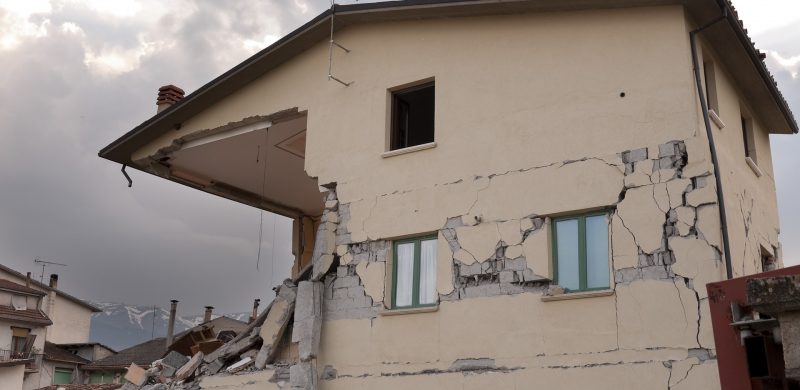
Oklahoma never used to be known for its earthquakes. Before 2009, the state had roughly two quakes of magnitude three and above each year. (Magnitude three is when things shake on the shelf, but before houses start getting damaged.) In 2015, this tally rocketed to more than 900, though it’s calmed since, falling to 304 last year.
This sudden increase is thought to be caused by the disposal of wastewater by the state’s booming industry, and it’s caught seismologists off-guard. As a historically quake-free area, Oklahoma doesn’t have enough equipment to detect and locate all these quakes, making it hard to investigate their root cause. “There are no major faults in Oklahoma so it’s just not something we would expect,” Thibaut Perol, a deep learning researcher who’s worked on this problem, tells The Verge. “And to understand what’s happening, we need a big, big catalogue of earthquakes.”
The solution proposed by Perol and his colleagues from Harvard University’s engineering and earth sciences departments is to use artificial intelligence to amplify the sensitivity of the state’s earthquake detectors, otherwise known as seismographs. In a paper published today in the journal Science Advances, they show how effective this technique is — capable of detecting 17 times more earthquakes than older methods in a fraction of the time.
The method is like the voice detection software used by digital assistants like Alexa and Siri, explains Perol. It’s all about uncovering the signal hidden in the noise. With Alexa, that means listening out for your voice commands while ignoring the background sound of your home. And for seismographs, it means cancelling out the normal geological rumblings of the Earth (what’s known as “ambient seismic noise”) to spot the earthquakes that might be very small or far away. This way, scientists in Oklahoma can get more out of the data they already have.
To make this happen, Perol and his colleagues trained a convolutional neural network to recognize background noise, feeding it data from seismically quiet areas, like pre-fracking era Oklahoma and the geological dead-zone of Wisconsin. (The state has only really had one significant earthquake, and that was in 1947.) As with all neural networks, the software examines this input and learns to pick out common patterns. Once it knows what ambient rumblings sound like, it can remove these from the data, leaving behind the tiny earthquakes that had previously been hidden — like sea shells revealed by a retreating tide. As a bonus, the neural network is even able to identify the rough whereabouts of individual quakes by matching the patterns they created with historical data where a tremor’s location was known.
“With this method we can detect earthquakes of magnitude zero or minus one, and these are signals you wouldn’t be able to see with a human eye,” says Perol.
William Yeck, a seismologist at the United States Geological Survey (USGS), praised the work as “compelling and novel.” Speaking to The Verge by email, he noted that the neural network would best apply to “local earthquake monitoring efforts” — as in Oklahoma — “where there are high-seismicity rates.” Yeck cautions, though, that earthquake detection is only ever going to be a part of the puzzle. “Estimations of earthquake sizes and accurate event locations are also necessary,” says Yeck. “For the very small events that this technique detects, this will be challenging.”
If this neural network can be used more widely in Oklahoma applied, says Perol, it’ll help seismologists investigate the exact cause of the state’s earthquakes. There’s even some hope that it could predict earthquakes before they occur. This could be done by looking for patterns in the data; for example, by finding times when many small earthquakes happen in quick succession, triggering up to a bigger, potentially damaging quake.
The idea of using AI to predict — not just detect — earthquakes is an exciting one, but it’s not something that the whole seismologist community is confident about. (You can watch the video below for more info.) In Oklahoma at least, prediction isn’t as important as detection. But with the help of Perol and his colleagues’ neural network, this important work could get a boost.
Oklahoma by no means was recognized for its earthquakes. Before 2009, the state had two quakes of magnitude 3 and above every year. (Magnitude 3 is when issues shake at the shelf, however ahead of properties get started getting broken.) In 2015, this tally rocketed to greater than 900, even though it’s calmed since, falling to 304 ultimate year.
This surprising build up is regarded as led to by way of the disposal of wastewater by way of the state’s booming fracking trade, and its stuck seismologists off-guard. As a traditionally quake-free space, Oklahoma doesn’t have sufficient apparatus to detect and find all those quakes, making it laborious to research their root reason. “There are no major faults in Oklahoma so it’s just not something we would expect,” Thibaut Perol, a deep studying researcher who’s labored in this downside, tells The Verge. “And to understand what’s happening, we need a big, big catalogue of earthquakes.”
“We need a big, big catalogue of earthquakes.”
“With this method we can detect earthquakes of magnitude zero or minus one, and these are signals you wouldn’t be able to see with a human eye,” says Perol.
If this neural community, dubbed ConvNetQuake, is extensively carried out, says Perol, it’ll assist seismologists in Oklahoma examine the precise reason behind the state’s earthquakes. There’s even some hope that it will expect earthquakes ahead of they happen. This may well be completed by way of on the lookout for patterns within the information; for instance, discovering occasions when quite a few small earthquakes occur in fast succession main as much as a larger, doubtlessly harmful quake.
The thought of the usage of AI to expect — no longer simply detect — earthquakes is an exhilarating one, nevertheless it’s no longer one thing that the entire seismologist neighborhood is assured about. (You can watch the video under for more information.) In Oklahoma no less than, prediction isn’t as vital as detection. But with the assistance of Perol and his colleagues’ neural community, this vital painting may get a spice up.





